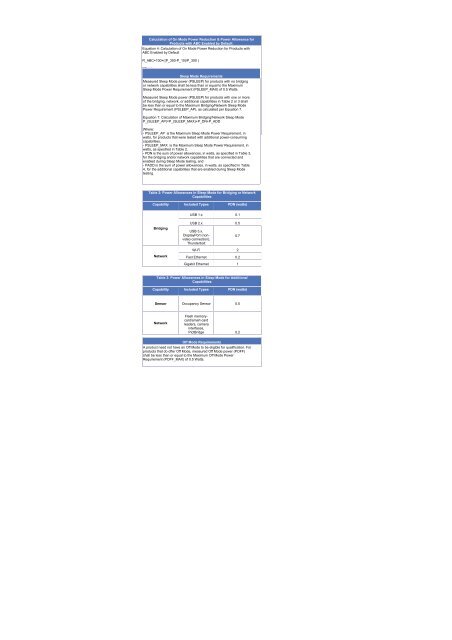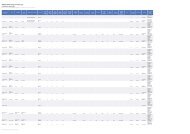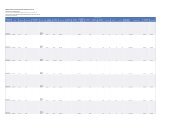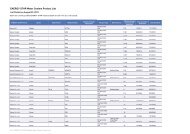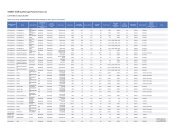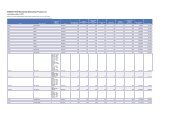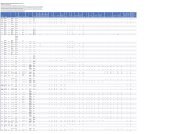Cadenza Document - Energy Star
Cadenza Document - Energy Star
Cadenza Document - Energy Star
You also want an ePaper? Increase the reach of your titles
YUMPU automatically turns print PDFs into web optimized ePapers that Google loves.
Calculation of On Mode Power Reduction & Power Allowance for<br />
Products with ABC Enabled by Default:<br />
Equation 4: Calculation of On Mode Power Reduction for Products with<br />
ABC Enabled by Default<br />
R_ABC=100×((P_300-P_10)/P_300 )<br />
Where:<br />
- RABC is the On Mode percent Sleep Mode power Requirements<br />
reduction due to ABC;<br />
- Measured P300 is the Sleep measured Mode power On Mode (PSLEEP) power, in for watts, products when with tested no bridging with an<br />
ambient or network light capabilities level of 300 shall lux, be and; less than or equal to the Maximum<br />
- Sleep P10 is Mode the measured Power Requirement On Mode power, (PSLEEP_MAX) in watts, when of 0.5 tested Watts. with an<br />
ambient light level of 10 lux.<br />
Measured Sleep Mode power (PSLEEP) for products with one or more<br />
Equation of the bridging, 5: Calculation network, of or On additional Mode Power capabilities Allowance in Table for Products 2 or 3 shall with<br />
ABC be less Enabled than or by equal Default to the Maximum Bridging/Network Sleep Mode<br />
P_ABC=0.10×P_(ON_MAX)<br />
Power Requirement (PSLEEP_AP), as calculated per Equation 7.<br />
Where: Equation 7: Calculation of Maximum Bridging/Network Sleep Mode<br />
- P_(SLEEP_AP)=P_(SLEEP_MAX)+P_DN+P_ADD<br />
PABC is the On Mode power allowance, in watts, and<br />
- PON_MAX is the maximum On Mode power requirement, in watts.<br />
Where:<br />
- PSLEEP_AP is the Maximum Sleep Mode Power Requirement, in<br />
watts, for products that were tested with additional power-consuming<br />
capabilities,<br />
- PSLEEP_MAX is the Maximum Sleep Mode Power Requirement, in<br />
watts, as specified in Table 2,<br />
- PDN is the sum of power allowances, in watts, as specified in Table 3,<br />
for the bridging and/or network capabilities that are connected and<br />
enabled during Sleep Mode testing, and<br />
- PADD is the sum of power allowances, in watts, as specified in Table<br />
4, for the additional capabilities that are enabled during Sleep Mode<br />
testing.<br />
Table 2: Power Allowances in Sleep Mode for Bridging or Network<br />
Capabilities<br />
Capability Included Types PDN (watts)<br />
USB 1.x 0.1<br />
Bridging<br />
Network<br />
USB 2.x 0.5<br />
USB 3.x,<br />
DisplayPort (nonvideo<br />
connection),<br />
Thunderbolt<br />
0.7<br />
Wi-Fi 2<br />
Fast Ethernet 0.2<br />
Gigabit Ethernet 1<br />
Table 3: Power Allowances in Sleep Mode for Additional<br />
Capabilities<br />
Capability Included Types PDN (watts)<br />
Sensor Occupancy Sensor 0.5<br />
Network<br />
Flash memorycard/smart-card<br />
readers, camera<br />
interfaces,<br />
PictBridge 0.2<br />
Off Mode Requirements<br />
A product need not have an Off Mode to be eligible for qualification. For<br />
products that do offer Off Mode, measured Off Mode power (POFF)<br />
shall be less than or equal to the Maximum Off Mode Power<br />
Requirement (POFF_MAX) of 0.5 Watts.


